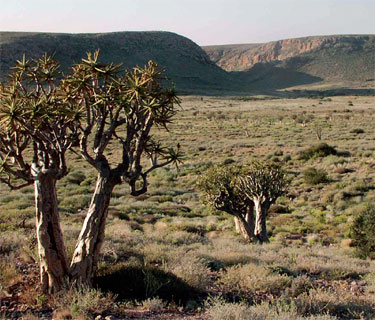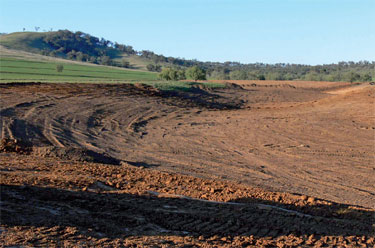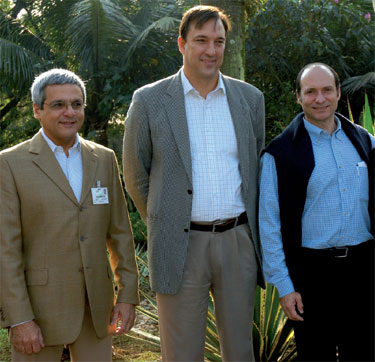|
Biodiversity conservation has been a cornerstone of our sustainable development strategy. A large number of biodiversity initiatives are undertaken across the Group, many of them in partnership with conservation bodies.

Biodiversity in Bushmanland’s Succulent Karoo, in South Africa’s Northern Cape province, will be protected under a Memorandum of Understanding between Anglo Base Metals and the Botanical Society of South Africa.
Since 2004, the focus has been
on developing biodiversity
action plans for significant sites
and ensuring that these meet
pre-defined international good
practice. During 2006, 13 sites
in Australia, the UK and South
Africa underwent peer review,
building on the work initiated in
2005 when 14 sites were
reviewed.
The process enables the sharing
of knowledge across the Group
and ensures that biodiversity
management is properly
incorporated into ISO 14001
systems and into the Group’s
Integrated Risk Management
system. All the operations
reviewed in 2006 demonstrated
understanding of the impact on
biodiversity and had included
this into risk management,
policy documents and
management tools. Tarmac’s
Northumberland region was
considered to be meeting its
commitment of a net positive
contribution to biodiversity.
Further improvement is needed
in terms of governance
structures for biodiversity
management, improved
monitoring against pre-defined
indicators and greater leadership
in tracking emerging biodiversity
risks and opportunities.
Remediation by Scaw Metals at
the Rietfontein landfill site is
showing excellent progress with
even the giant bullfrogs,
classified as a near-threatened
species in South Africa,
showing their approval in two
rare sightings.
Following a pilot study, the site
was fully planted in 2006 with
trees and plants specially
selected for their tolerance
of adverse conditions and their
ability to contain or neutralise
pollutants.
An aerial survey and monitoring
work by researchers from the
Witwatersrand and Tel Aviv
universities have found no
mineral contamination of the
planted areas around the site.
Anglo Platinum is working with
bird-watchers to protect the
yellow-throated sandgrouse –
an endangered bird species
found in the Northam area of
the Limpopo province in
South Africa.
Research began in July 2006
to assess changes in the
population of sandgrouse,
compared with a 1992 study,
and to investigate the impact of
any significant changes in
habitat, farming practices or
water supply. The
Witwatersrand Bird Club will
also establish whether the birds
are breeding successfully.
Bushmanland is one of the nine
priority areas of the Succulent
Karoo Ecosystem Programme
(SKEP) where, to date, an
astonishing 854 plant species
have been found in this desert
landscape. Of these,
41 species are endemic. It is
the only priority area in the
internationally renowned
Succulent Karoo biodiversity
hotspot to have no land under
formal conservation protection.
As the legal regime for
declaring protected areas is still
under development in this
region, Anglo Base Metals and
the Botanical Society of South
Africa have signed a
Memorandum of Understanding
(MOU) to work in partnership
to secure and protect this
area’s biodiversity. The MOU
assigns roles and
responsibilities and details
commitments and expectations
of the parties.
Anglo Coal is working in
partnership with the New South
Wales State government to
restore natural habitats in the
Hunter Valley area which had
been eroded after decades of
poor agricultural practice.
Communities had expressed
concern that erosion of
Saltwater creek, a tributary of
the Hunter river, might affect
local wildlife and water
supplies. The erosion was being
accelerated by high rainfall
events. Water supplies were
reduced as natural ponds were
destroyed and vegetation
around water courses was
degraded, further extending
the erosion.
Over time, this caused a
decline in food, water and
shelter for local wildlife and
biodiversity was decreasing.
The project will build up the
banks of the creek to prevent
further erosion. Once
completed, indigenous trees
and shrubs will be grown on
the earth banks to provide
natural habitat for wildlife.

Rehabilitation work is being undertaken to repair the severely eroded Australian Hunter Valley.
The 8,000 hectare El Soldado
mine property is located in the
Cordillera El Melón mountain
range, which Chilean
environmental authorities
classify as a priority area for
the conservation of terrestrial
ecosystems. Anglo American
Chile is working to improve the
scientific knowledge and build
community awareness of the
natural heritage of this
ecosystem, which is
characterised by diverse
Mediterranean forests with
endemic fauna and flora.
Since 2002, the company has
worked with the Christa Mock
agricultural high school from
Nogales to research the
propagation methods for native
forest species that are
threatened or vulnerable.
More than 20,000 native plants
such as the Belloto del Norte
(Beilschmiedia miersii),
Guayacán (Porlieria chilensis),
Naranjillo (Citronella
mucronata), Temu
(Blepharocalyx cruckshanksii)
and Lingue (Persea lingue) have
been propagated to date, with a
further 60,000 plants destined
for use in or around Anglo
American Chile’s properties
in the region in the next
three years.
Small landowners in the
communities close to El Soldado
have also signed agreements to
grow an additional 20,000
plants for use by the company
in afforestation projects.
Copebrás is in Cubatão, an
industrial centre in the Brazilian
Atlantic rain forest region, one
of the world’s most diverse
ecosystems. The Atlantic rain
forest is also home to 70% of
Brazil’s population and human
impact has been significant,
with less than 7% of the
original ecosystem remaining.
The company has, therefore,
chosen to focus its social
responsibility activities on
contributing to the
understanding and conservation
of the country’s unique
natural heritage.
Brazil has the world’s largest
floral diversity, the largest
number of mammals,
amphibians and freshwater fish
and ranks third for birds and
fifth for reptiles. Many of the
species are, however, not
properly recorded. Brazilian
authorities estimate that only
10% or 200,000 species are
fully described.
Copebrás is subsidising research
and conservation projects
through small private
companies, research institutions
and NGOs. It has funded a
major inventory and monitoring
programme in an area
connected to the Serro do Mar
mountain range which is now
among the last 7% of the
Atlantic rain forest biome.
A study, conducted monthly
over two years, found:
- 341 species of plants,21 classified as threatened
with extinction
- 27 mammal species,
including 12 threatened
species such as ocelots
(Leopardus pardalis),
oncillas (Leopardus
tigrinus) and agoutis
(Dasyprocta sp)
- 163 species of birds, of
which three are near
extinction on a world level
- 24 amphibian species and
several endemic species of
reptile, and
- 2 species of amphibians
and invertebrates
considered new to science.
A control area with a similar
environment, but without such
significant human impact, will
now be identified. There is also
a proposal to develop a
rehabilitation area for illegally-
captured animals and a nursery
to generate seeds and saplings
for use in rehabilitation work.

The president of SOS Mata Atlantica Foundation, Dr Roberto Klabin, right, received the 2006 Copebrás Environmental Award, from Dr Cristiano Melcher, centre. Pictured here with San Martin, Copebrás environmental consultant. The company presents the annual award – a model of the Scarlet Ibis (Eudocimus ruber) bird – to organisations and personalities who work to protect the environment. Klabin took the opportunity to launch a preservation programme for the Brazilian coast and marine zone at the event. This is a pioneering campaign to preserve and restore the Brazilian coastline, which Klabin said was one of the most degraded regions of the world.
Catalão, Barro Alto and
Níquelândia are located in the
Brazilian cerrado in the state
of Goiás. The cerrado biome
includes fields, savannas and
forests, and is considered one
of the 25 most threatened
biodiversity hotspots with
several species threatened with
extinction. Recent estimates
show that 50% of the native
vegetation has been destroyed
and less than 5% of the total
area enjoys conservation status.
Human occupation has modified
the natural environment and
caused an accelerated
biodiversity loss. Exploration in
this mineral-rich part of the
world has brought economic
gain but serious problems of
erosion, environmental
degradation and biodiversity
loss.
Anglo American companies are
contributing to the preservation
of the fauna and flora in the
area. Níquelândia is one of
22 areas chosen by the
Environmental Agency in 2005
as of interest for cerrado
biodiversity conservation as
it is a corridor to the Paranã
valley and Chapada dos
Veadeiros national park and is
critical to biodiversity and
ecological processes.
Scholarships for graduate and
postgraduate students have
been awarded and 16
academics and students are
studying three areas inside the
Anglo American properties.
The area has laterite and
saprolite nickel deposits, with
high concentrations of nickel,
magnesium and iron and low
concentrations of important
nutrients for the flora, such as
calcium and potassium. There
are a number of endemic
species with a notable ability
to selectively accumulate
the nickel.
The areas managed by Codemin
are diversified and well
preserved and initial work
consisted of identifying and
monitoring amphibians, reptiles,
birds and mammals.
At Barro Alto, after an
environmental impact
assessment in 2000 and ahead
of the viability stages of the
new project, four campaigns
were run to monitor the fauna.
The campaigns will continue
with the provision of transport,
community education
programmes, initiatives to stop
hunting and exclude dogs from
the conservation areas, and the
ongoing collection of poisonous
snakes to prevent safety
problems. A study of the flora
will also be carried out.
|